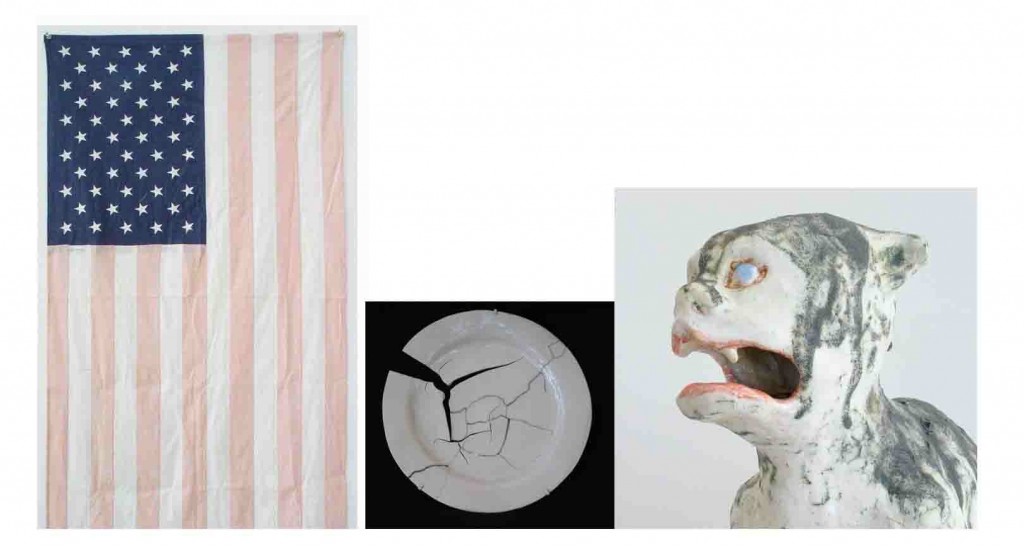Mary Carlson at Elizabeth Harris
Texting reigns but word of mouth is alive and well. This exquisite show, the kind easily overlooked by the art media, was widely praised with a happy sense of discovery by artists on the street. Extremely understated, Carlson’s installation yields outsized results, a plenitude of echoes and connections. Epic subject matter is presented through sleight of hand—determinacy hidden but effects undeniable.
A huge American flag, sewn by the artist, literally blocks access to a roomful of small ceramics. The flag is faded glory, patched-looking and thinned almost to transparency. The ceramics consist of wall and pedestal-mounted cracked plates and bowls and two “demons”, a hydra and a devil dog. These items are equally wedded to the aesthetic of fragility, cast so thinly that damage is more than invited, it is positively romanced. Flag and porcelain elucidate the difference between shopworn and timeworn. With its expansionist ambitions clearly stated in size and placement, the America of Carlson’s flag is tired rather than aged. Although there is a whiff of the old vanished American values of making do and using up, of quilts and re-purposing , the past thus conjured up is itself threadbare compared to the long endurance of that glazed and cracked china. In fact, the very word “china” –the informal term for porcelain, born in China –evokes America’s great other, what used to be called “The Orient.” And the presence of hydra and devil dog not only references Asian figurines, but slyly emphasizes the demonizing of East by West and vice versa.
But white devil/yellow devil notwithstanding there is a certain syncretism at work here. While a culture figured in the impermeable endurance of a glazed surface, fissured but ultimately resistant to shock and attack may face off against an exhausted but still powerful imperialism, juxtaposing such seemingly disparate realms as large and small, textile and plate, east and west ultimately suggests a commonality of endlessly reversible roles. We are reminded that it is the East that now fares better than the West, at least economically. “Sic transit gloria.” The size of that flag and the damage of the ceramics recalls Admiral Perry’s bullying “opening up “ of Japan, for instance, although Perry apparently sent not red, white and blue but white flags for the Japanese to hoist when they no longer wished to withstand his bombardment. The irony is that this “surrender” ultimately led the Japanese to develop modern weapons and a modern economics—both of which eventually came back to haunt the U.S.
There is a further suggestion made by Carlson’s contrasts that has nothing to do with east and west. Namely, that the endless see-saw of international dominance pivots on the vulnerability of the domestic. Those carefully mended plates embody the private cost of politics, the cracking of the everyday, the small possession, the pathetic heirloom under the pressure of an overbearing intrusive imperialist public policy. The triumph of the big over the small seems to be on Carlson’s mind; she is quoted as saying that the impetus for making her flag was outrage over the Supreme Court’s refusal to limit corporate spending on campaign finance. What hope then, for the small gesture? Well, Carlson’s exhibition is itself proof that there is hope. This is political art of the best sort, the politics conveyed not just by images and, thankfully, speechlessly, but through texture. Looking at Carlson’s outsized worn-out flag the viewer is most aware of its clothness, its tenuous physicality, and the phrase “fabric of history” takes on new meaning. This is information which, though we take it in with our eyes, seems to enter through the extra-sensitive pads of our fingertips: running over the smooth impervious glaze of the plates, snagged on the chipped edges; meanwhile the flag might crumble at a touch. Carlson has the tact to allow breathing room for the viewers. Her lacuna—the unexplicated gap between flag and ceramics– literally provides space and time for the information to circulate through their senses and percolate to conclusions. No exhortations.
Howard Foster






